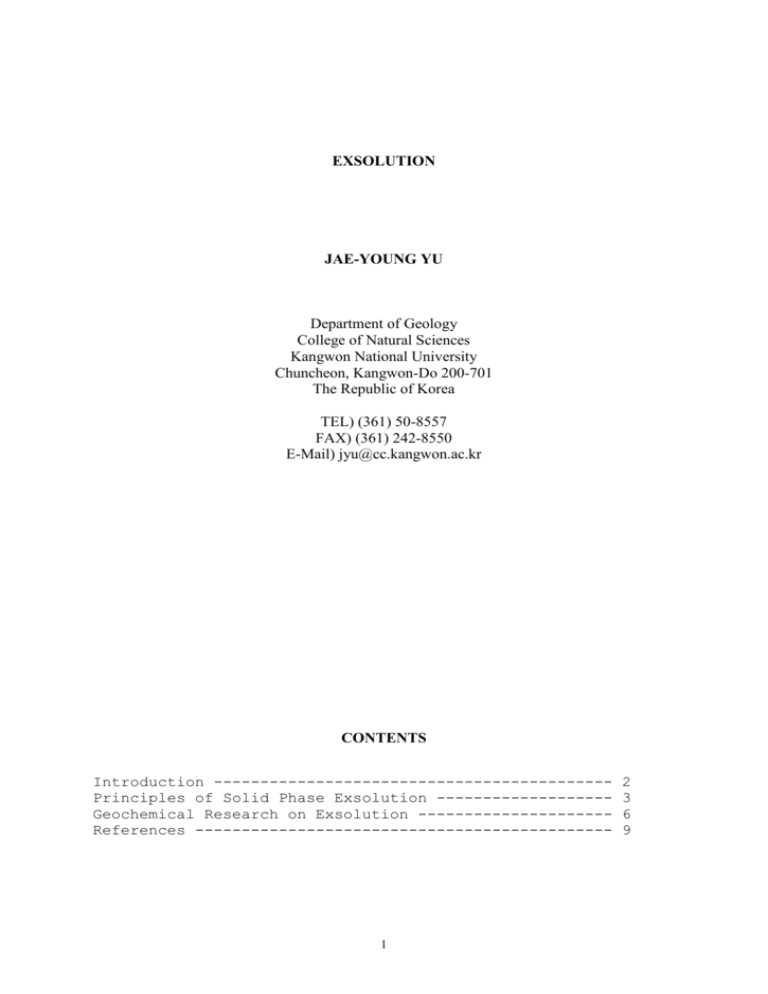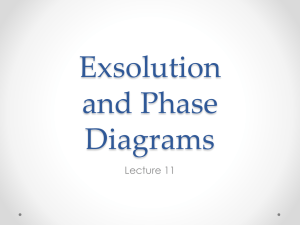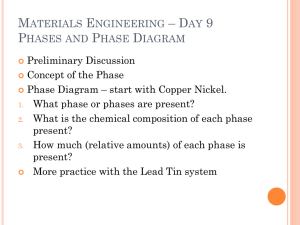EXSOLUTION
advertisement

EXSOLUTION JAE-YOUNG YU Department of Geology College of Natural Sciences Kangwon National University Chuncheon, Kangwon-Do 200-701 The Republic of Korea TEL) (361) 50-8557 FAX) (361) 242-8550 E-Mail) jyu@cc.kangwon.ac.kr CONTENTS Introduction ------------------------------------------Principles of Solid Phase Exsolution ------------------Geochemical Research on Exsolution --------------------References --------------------------------------------- 1 2 3 6 9 EXSOLUTION Introduction Exsolution is the term applied to the processes of the separation of an initially homogeneous solution phase into two compositionally different immiscible phases. Exsolution occurs when a solution phase becomes less stable than its component phases. The instability of the solution phase may be triggered by a change in temperature (T), pressure (P), or chemical composition (X). Both of T and P are geologically important system parameters. Most geological systems are mainly comprised of solid phases with minor amount of fluids. Exsolution of fluid solutions are dependent both on T and P. On the other hand, exsolution of solid solutions significantly depends only on T, because solid phases usually show little volume change with pressure variation. Exsolution begins on an atomic scale (cross reference to "Mineral Defects" ). As exsolution continues, the exsolved phases usually form subparallel lamellae, films or irregular patches. Such intergrowths may be observable with native eyes, but generally are observed at microscopic to submicroscopic scale. Geochemical examples of exsolution are numerous, but probably the most well known one is separation of albite from K-feldspar to form perthite. Albite and K-feldspar (usually sanidine) form a complete solid solution at high T (probably higher than 650 to 700oC, depending on P). As temperature decreases, however, the solid solution becomes unstable and is separated into two immiscible phases, albite + ordered orthoclase or albite + microcline. Fluid phases, such as H2O, CO2, CH4, O2, N2, H2, S2, and H2S, have been regarded not only to be involved but also to play important roles in various geological processes. However, the research on exsolution of the fluid solutions (usually referred to as immiscibility) has been not so extensive, because 1) most of the exsolved fluid phases usually escape from and are not observable in rock specimens, 2) the experimental data in laboratory are often difficult to extrapolate to the conditions of deep geological processes, 2 and 3) the fluid phases may have complex chemical paths that we don't recognize. For these reasons, this article focuses on the exsolution of solid solutions. One of the well known geochemical examples of fluid exsolution is bubbling of CO2 from H2O-CO2 supercritical solution around 270oC (e.g. Belonoshko and Saxena, 1992). Principles of Solid Phase Exsolution Exsolution may be best understood by comparing the Gibbs free energy of a solution phase with those of its component phases. For simplicity, consider the following reaction of mixing of two compositionally different phases, p1 and p2, to form a solid solution phase, S, in a binary system at given T and P; 1p1 + 2p2 = S, (R1) where 1 and 2 are respectively the mole fractions of p1 and p2 in S. Note that p1 and p2 need not to be the end-members of the system. between those of the end-members. Instead, they can have any composition If the molal Gibbs free energies of p1 and p2 at given T,P T,P T and P are G T,P p1 and G p2 , the Gibbs free energy change of the above reaction, G rxn , becomes T,P T,P G T,P - 1G T,P rxn = GS p1 - 2 G p2 , T,P where G S (1) is the molal Gibbs free energy of the solution phase (product). The molal Gibbs free energy of a solution phase is generally expressed as G = X i 0i + RT X i lna i = X i 0i + G mix , i where Xi, i0, i (2) i and ai are the mole fraction, standard chemical potential, and activity of component i, respectively. G mix in equation (2), called free energy of mixing, has the form of G mix = RT X i lna i = RT X i lnX i + RT X i ln i =G id + G ex , (3) i i i where i, G id , and G ex are the activity coefficient of i, free energy, respectively. ideal mixing free energy, and excess For further discussion on the thermodynamic functions of solid solutions, see "Solid Solution". From equations (1), (2), and the stoichiometry of reaction (R1), T, P T, P T, P G T,rxnP = G mix, S - 1G mix, p1 + 2 G mix, p2 . (4) 3 If T,P T,P T,P G T,P rxn 0, that is G mix ,S ( 1G mix , p1 + 2 G mix , p2 ) , then solution phase S should be stable. Any system parameter variation making G T,P rxn positive from negative evokes exsolution of the solid solution phase S, and consequently two separated phases p1 and p2 should stably exist. When exsolution occurs, the chemical compositions of the exsolved phases, p1 and p2, T,P may be determined from so called "Gmix-X curves", which plots G mix ,S against the mole fraction Figure 1 shows a typical Gmix-X curve of the solid solution in a hypothetical binary system whose end-members are A and B. T,P T,P If Gex 0 or Gid has a large negative (X) of an end-member. T,P T,P value at sufficiently high temperature so that Gex is negligible with respect to Gid , T,P T,P G mix ,S G id and Gmix-X curve has a parabolic form concave downward. ( 1G mix , p1 T,P T,P In this case, G mix ,S T,P + 2 G mix , p2 ) in the compositional range of 0XB1.0, and a complete solid solution T,P should be formed. A complete solution also can be formed when Gex 0. On the other T,P T,P hand, if Gid is negligible with respect to Gex , which may occur when A and B produce T,P T,P T,P large Gex at a relatively low temperature, G mix ,S G ex and Gmix-X curve has a parabolic form concave upward. 0XB1.0 T,P T,P T,P In this case, G mix ,S ( 1G mix , p1 + 2 G mix , p2 ) in the compositional range of and A and B can not form any solution. Most solid solutions show the mixing T,P T,P T,P properties intermediate between the above two extreme cases. Then, G mix ,S G id + G ex and the Gmix-X curve generally has two local minima and one local maximum. In this case, T,P T,P T,P G mix ,S is not always greater or lesser than ( 1G mix , p1 + 2 G mix , p2 ) and thus, the solutions may stably exist or exsolve into two immiscible phases depending on the chemical composition of the system. Figure 2 shows the details of the tangent to the two minima of Gmix-X T,P G mix ,S curve in Figure 1. We may draw a line simultaneously curve. Let XB values of the two tangent points be X1 and X2, which are identical to the mole fractions of B in p1 and p2, respectively. The free T,P T,P energies on the tangent line represent the quantity ( 1G mix , p1 + 2 G mix , p2 ) , which are always more negative than those on T,P G mix ,S curve. Then, as equation (4) suggests, the solutions of the chemical compositions of X1XBX2 should be exsolved into p1 and p2. The chemical compositional range of X1XBX2 is called miscibility gap. Any solution having the chemical composition in the ranges of 0XBX1 and X2XB1 should stably exist, because there is no such tangent T,P line having more negative values than G mix ,S curve in these ranges. 4 It is generally difficult to obtain the exact equation for the line simultaneously tangent to the two minima of the T,P T,P G mix ,S curve, because G mix ,S is a complicated function of T and X for a given P. The minima occur at the XB values satisfying the following two conditions; T, P T, P 2 G mix, G mix, S S 0.0 . = 0.0 and 2 X X B B (5) The solution of the above equation may be obtained through computerized iteration algorithms. In many cases, however, investigators graphically determine the two tangent points by arbitrarily moving a line until it simultaneously contacts the two minima. Many of the reported miscibility gaps have been actually determined with the chemical compositions of the coexisting exsolved phases from natural systems or synthesis experiments. If only the free energies are known, the method described above may be used to determine the miscibility gaps. At a given P, the miscibility gap generally becomes narrower as T increases, because the negative T,P contribution from G id (3)). T,P much more rapidly increases than the positive contribution from G ex (see equation G idT,P is the free energy solely due to the entropy change introduced by mixing. Thus, the amount of T,P G idT,P variation is linearly proportional to the amount of T variation. On the other hand, G ex is the free energy due to the all the energetic effects caused by such strains among the substituents as the changes in bond lengths, bonding angles and ionicities of the bondings. variation. These strains may not change much in response with T In particular, solids show insignificant variation of the strains as a function of T. Thus, becomes more negative as T,P G mix ,S G idT,P predominates at higher T, which produces the narrower miscibility gap. Figure 3a shows the typical Gmix-X curves at different temperatures. The curve connecting the miscibility gaps (solid circles) at different temperatures is called solvus. Figure 3b is a T-X phase diagram showing the solvus (solid curve) obtained from the miscibility gaps in Figure 3a. The solvus divides the stability field into one phase (solid solution phase) and two phases (exsolved phases) regions. Figure 3b shows another curve (broken curve) called the spinodal. The spinodal curve connects the inflection points (open circles in Figure 3a) of Gmix-X curves at different temperatures. The inflection points occur at the XB values, satisfying the following conditions; G T,mixP X B = 0 and 2 G T,mixP 2 X B = 0 . (6) 5 Figure 4 shows more detail of the rectangularly shaded part in Figure 2. Let X 1' be the XB value of the inflection point and p1' be the corresponding phase. The line connecting the tangent point T,P and the inflection point is less negative than the G mix ,S curve in the compositional range of XiXBXi'. It means that a solution phase having the chemical composition in this range is more stable than the exsolved phases, p1 and p1'. Due to this unique property of the Gmix-X curve between the tangent point and the inflection point, the system may maintain the solid solution for a fair amount of time, although it is of course less stable than p1 and p2 and ultimately exsolves into them. Thus, the area defined by the solvus and spinodal in Figure 3 represents the range of T and X condition allowing a solid solution to metastably exist. Exsolutions in multicomponent systems may be more complicated than in binary systems, but the basic principles discussed above apply exactly. See Mukhopadhyay, Basu and Holdaway (1993) for the discussion on the multicomponent solutions. Geochemical Research on Exsolution Solid solutions are common among minerals, and most of them exsolves under the appropriate conditions of T, P, and X. For the extensive review and discussion on exsolution of the solid solutions, see Hovis, Delbove and Bose (1991) for feldspar, Buseck, Nord and Veblen (1980) for pyroxenes, Ghose (1981) for amphiboles, Blencoe, Guidotti and Sassi (1994) and Guidotti et al. (1994) for micas, Andersen, Bishop and Lindsley (1991) for oxides, Essene (1983) for carbonates, and Craig and Scott (1976) for sulfides. Exsolution of solid solutions have been applied to geothermobarometry, which we call solvus thermobarometry. The chemical compositions of the exsolved phases from a solid solution are usually a sensitive function of T and sometimes of P. Thus, the chemical compositions of the exsolved phases should provide crucial information on thermal and burial history of a geologically interesting terrain and it's T-P-t evolution path. Although a huge pile of exsolution data of numerous solid solutions are available, just a few of them can be used as geothermobarometers due to the uncertainties and discrepancies among the data 6 obtained by different geochemists. Recently, Gasparik (1990) revised the thermodynamic model of enstatite-diopside join and Douce, Johnston and Rice (1993) discussed the possible utilization of biotite as a geothermometer-geobarometer. The limited applicability of the exsolution data to geothermobarometry comes from both experimental and theoretical uncertainties. To obtain thermodynamic properties of a solution, investigators usually perform mineral syntheses and/or calorimetric measurements assuming their experimental systems always achieve an equilibrium state. However, the equilibrium assumption often fails. The phases in the experimental systems may exist metastably during the relatively short time duration and consequently the reactions may be not reversed (Circone and Navrotsky 1992). invalid. In this case, any measurements or analyses are Even though the system actually reached an equilibrium state, the identification and chemical analyses of the products can be problematic, because the synthesized minerals are often poorly crystalline and form a mixture of less than microscopic sized grains. These may be the reasons why there are so many discrepancies among the experimental data of the same material. The theoretical formulation of the experimental data is not a problem-free task either. There are a few solution models, but the most popular one for real solutions may be the model using Margules' formulation on excess free energy. Margules equation is a polynomial function of X and T, but often unable to account all the variations in excess free energy of real solutions. Modeling of entropy change due to mixing may be another problem. The site mixing model is generally adopted to describe entropy change in solid solutions. Recent structural investigations with NMR and M7ssbauer spectrometry reveal more about the cationic configurations in some minerals (Brown et al. 1993; Rancourt et al. 1994). However, our current knowledge on the distribution of the constituent species among the structural sites is not yet sufficient to satisfactorily describe the mixing properties of most solid solutions. Despite all of the above difficulties, solvus geothermobarometers are invaluable in attacking various geological problems. Moreover, development of more advanced analytical instruments and refinement of current theoretical models in the near future will 7 greatly improve the accuracy and applicability of solvus geothermobarometers. Then, solvus geothermobarometer will be more powerful tool in elucidating T-P-t path of a geologic terrain and more widely applicable to various geologic problems. JAE-YOUNG YU 8 References Andersen, D.J., Bishop, F.C., and Lindsley, D.H. 1991. Internally consistent solution models for Fe-Mg-Mn-Ti oxides: Fe-Mg-Ti oxides and olivine. American Mineralogist 76: 427-444. Belonoshko, A.B. and Saxena, S.K. 1992. A unified equation of state for fluids of C-H-O-NS-Ar composition and their mixtures up to very high temperatures and pressures. Geochimica et Cosmochimica Acta 56: 3611-3626. Blencoe, J.G., Guidotti, C.V., and Sassi, F.P. 1994. The paragonite-muscovite solvus: II. Numerical geothermometers for natural, quasibinary paragonite-muscovite pairs. Geochimica et Cosmochimica Acta 58: 2277-2288. Brown, N.E., Navrotsky, A., Nord, G.L. Jr., and Banerjee, S.K. 1993. Hematite-Ilmenite (Fe2O3-FeTiO3) solid solutions: Determinations of Fe-Ti order from magnetic properties. American Mineralogist 78: 941-951. Busek, P.R., Nord, G.L., and Veblen, D.R. 1980. Subsolidus Phenomena in Pyroxenes. In Reviews in Mineralogy, 7, Pyroxenes, ed. C.T. Prewitt, pp 117-221. Mineralogical Society of America.. Circone, S. and Navrotsky, A. 1992. Substitution of [6,4]Al in phlogopite: High-temperature solution calorimetry, heat capacities, and thermodynamic properties of the phlogopite-eastonite join. American Mineralogist 77: 1191-1205. Craig, J.R. and Scott, S.D. 1976. Sulfide Phase Equilibria. In Reviews in Mineralogy, 1, Sulfide Mineralogy, ed. P.H. Ribbe, pp CS-1-CS-110. Mineralogical Society of America. Douce, A.E.P., Johnston, A.D., and Rice, J. 1993. Octahedral excess mixing properties in biotite: A working model with applications to geobarometry and geothermometry. American Mineralogist 78:113-131. Essene, E.J. 1983. Solid Solutions and Solvi among Metamorphic Carbonates with Applications to Geologic Thermobarometry. In Reviews in Mineralogy, 11, 9 Carbonate: Mineralogy and Chemistry, ed. R.J. Reeder, pp 77-96. Mineralogical Society of America. Gasparik, T. 1990. A thermodynamic model for the enstatite-diopside join. American Mineralogist 75: 1080-1091. Ghose, S. 1981. Subsolidus Reactions and Microstructures in Amphiboles. In Reviews in Mineralogy, 9A, Amphiboles and Other Hydrous Pyriboles-Mineralogy, ed. D.R. Veblen, pp 325-368. Mineralogical Society of America. Guidotti, C.V., Sassi, F.P., Blencoe, J.G., and Selverstone, J. 1994. The paragonite-muscovite solvus: I. P-T-X limits derived from the Na-K compositions of natural, quasibinary paragonite-muscovite pair. Geochimica et Cosmochimica Acta 58: 2269-2276. Hovis, G.L., Delbove, F., and Bose, M.R. 1991. Gibbs energies and entropies of K-Na mixing for alkali feldspars from phase equilibrium data: Implications for feldspar solvi and short-range order. American Mineralogist 76: 913-927. Mukhopadhyay, B., Basu, S., and Holdaway, M.J. 1993. A discussion of Margules-type formulations for multicomponent solutions with a generalized approach. Geochimica et Cosmochimica Acta 57: 277-283. Rancourt, D.G., Christie, I.A.D., Royer, M., Kodama, H., Robert, J.-L., Lalonde, A.E., and Murad, E. 1994. Determination of accurate [4]Fe3+, [6]Fe3+, and [6]Fe2+ site populations in synthetic annite by M10ssbauer spectroscopy. American Mineralogist 79: 51-62. Cross References: Free Energy; Geothermometry; Mineral Defects; Phase Equilibria; Solid Solution. 10






